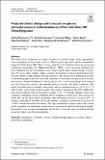Files in this item
Projected climate change and its impacts on glaciers and water resources in the headwaters of the Tarim River, NW China/Kyrgyzstan
Item metadata
| dc.contributor.author | Wortmann, Michel | |
| dc.contributor.author | Duethmann, Doris | |
| dc.contributor.author | Menz, Christoph | |
| dc.contributor.author | Bolch, Tobias | |
| dc.contributor.author | Huang, Shaochun | |
| dc.contributor.author | Tong, Jiang | |
| dc.contributor.author | Kundzewicz, Zbigniew W. | |
| dc.contributor.author | Krysanova, Valentina | |
| dc.date.accessioned | 2022-04-20T15:51:09Z | |
| dc.date.available | 2022-04-20T15:51:09Z | |
| dc.date.issued | 2022-04-18 | |
| dc.identifier | 279142589 | |
| dc.identifier | 9570257e-7ec6-4a31-80fc-767e3bd14e0a | |
| dc.identifier | 000783477300001 | |
| dc.identifier | 85128397872 | |
| dc.identifier.citation | Wortmann , M , Duethmann , D , Menz , C , Bolch , T , Huang , S , Tong , J , Kundzewicz , Z W & Krysanova , V 2022 , ' Projected climate change and its impacts on glaciers and water resources in the headwaters of the Tarim River, NW China/Kyrgyzstan ' , Climatic Change , vol. 171 , no. 3-4 , 30 . https://doi.org/10.1007/s10584-022-03343-w | en |
| dc.identifier.issn | 0165-0009 | |
| dc.identifier.other | Jisc: 249615 | |
| dc.identifier.other | publisher-id: s10584-022-03343-w | |
| dc.identifier.other | manuscript: 3343 | |
| dc.identifier.other | ORCID: /0000-0002-8201-5059/work/111975658 | |
| dc.identifier.uri | https://hdl.handle.net/10023/25218 | |
| dc.description | This study was conducted within the project SuMaRiO (Sustainable Management of River Oases along the Tarim River; http://www.sumario.de/), funded by the German Federal Ministry of Education and Research (BMBF grants 01LL0918J, 01LL0918I and 01LL0918B). T. Bolch acknowledges funding by Deutsche Forschungsgemeinschaft (DFG, BO3199/2–1). Open Access funding enabled and organized by Projekt DEAL. | en |
| dc.description.abstract | Glacierised river catchments are highly sensitive to climate change, while large populations may depend on their water resources. The irrigation agriculture and the communities along the Tarim River, NW China, strongly depend on the discharge from the glacierised catchments surrounding the Taklamakan Desert. While recent increasing discharge has been beneficial for the agricultural sector, future runoff under climate change is uncertain. We assess three climate change scenarios by forcing two glacio-hydrological models with output of eight general circulation models. The models have different glaciological modelling approaches but were both calibrated to discharge and glacier mass balance observations. Projected changes in climate, glacier cover and river discharge are examined over the twenty-first century and generally point to warmer and wetter conditions. The model ensemble projects median temperature and precipitation increases of + 1.9–5.3 °C and + 9–24%, respectively, until the end of the century compared to the 1971–2000 reference period. Glacier area is projected to shrink by 15–73% (model medians, range over scenarios), depending on the catchment. River discharge is projected to first increase by about 20% in the Aksu River catchments with subsequent decreases of up to 20%. In contrast, discharge in the drier Hotan and Yarkant catchments is projected to increase by 15–60% towards the end of the century. The large uncertainties mainly relate to the climate model ensemble and the limited observations to constrain the glacio-hydrological models. Sustainable water resource management will be key to avert the risks associated with the projected changes and their uncertainties. | |
| dc.format.extent | 24 | |
| dc.format.extent | 3856485 | |
| dc.language.iso | eng | |
| dc.relation.ispartof | Climatic Change | en |
| dc.subject | Tarim River | en |
| dc.subject | SWIM-G | en |
| dc.subject | WASA | en |
| dc.subject | Climate change impact assessment | en |
| dc.subject | Glacio-hydrological modelling | en |
| dc.subject | GE Environmental Sciences | en |
| dc.subject | NDAS | en |
| dc.subject | SDG 13 - Climate Action | en |
| dc.subject.lcc | GE | en |
| dc.title | Projected climate change and its impacts on glaciers and water resources in the headwaters of the Tarim River, NW China/Kyrgyzstan | en |
| dc.type | Journal article | en |
| dc.contributor.institution | University of St Andrews. School of Geography & Sustainable Development | en |
| dc.contributor.institution | University of St Andrews. Bell-Edwards Geographic Data Institute | en |
| dc.contributor.institution | University of St Andrews. Environmental Change Research Group | en |
| dc.identifier.doi | https://doi.org/10.1007/s10584-022-03343-w | |
| dc.description.status | Peer reviewed | en |
This item appears in the following Collection(s)
Items in the St Andrews Research Repository are protected by copyright, with all rights reserved, unless otherwise indicated.

